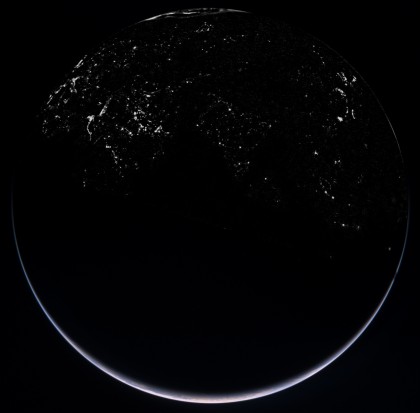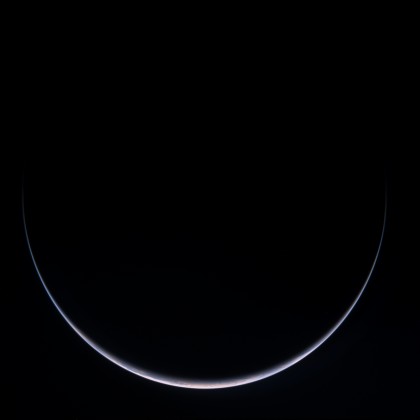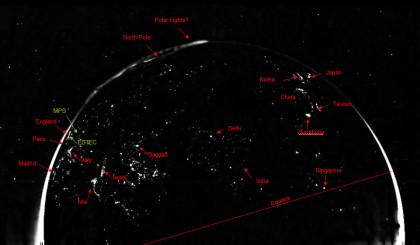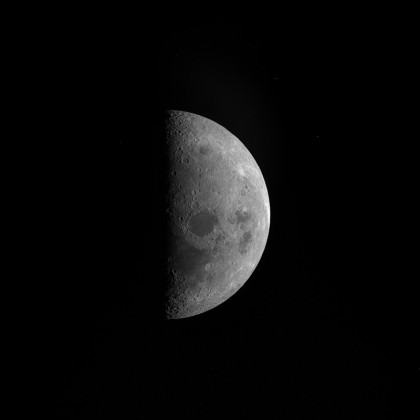Press Release 15/2007 - 15th November 2007
First OSIRIS images from Rosetta Earth swing-by
During its 10 year cruise to comet Churyumov-Gerasimenko ESA’s  Rosetta spacecraft performs four planetary (3 times Earth, once Mars) and 2 asteroid flybys. After the successful Mars swing-by in Feb. 2007, the second Earth swing-by took place in the evening of Nov. 13.
Rosetta spacecraft performs four planetary (3 times Earth, once Mars) and 2 asteroid flybys. After the successful Mars swing-by in Feb. 2007, the second Earth swing-by took place in the evening of Nov. 13.
The scientific camera system  OSIRIS, built by an European consortium lead by MPS, observed the earth during the swing-by of the Rosetta spacecraft. First images are shown in Fig. 1 - Fig. 3
OSIRIS, built by an European consortium lead by MPS, observed the earth during the swing-by of the Rosetta spacecraft. First images are shown in Fig. 1 - Fig. 3

|
Figure 1: Composite of four WAC images which shows both, the city lights in the Northern hemisphere and the illuminated crescent around Antarctica.
|
(Image: ESA ©2007 MPS for OSIRIS Team
MPS/UPD/LAM/IAA/RSSD/INTA/UPM/DASP/IDA)
|

|
Figure 2: This image was taken with the OSIRIS Wide Angle Camera (WAC) at 19:05h UTC. At that time Rosetta was about 75000 km from the Earth. The image shows the small sun illuminated crescent around Antarctica. The image is a pseudo color composite based on the OSIRIS wide angle camera (WAC) OI (630 nm, 20 ms exposure time) and CN (388 nm, 38 ms exposure time) filters with interpolated green.
|
(Image: ESA ©2007 MPS for OSIRIS Team
MPS/UPD/LAM/IAA/RSSD/INTA/UPM/DASP/IDA)
|

|
Figure 3: Image taken with the OSIRIS Wide Angle Camera (WAC) at 18:45h UTC, about 2 h before the closest approach of the spacecraft to the earth. At that time Rosetta was about 80,000 km above the Indian Ocean where the local time approached midnight (phase angle sun-earth-Rosetta ca. 160°). Islands of artificial lights of human habitations are sparsely distributed over the globe. The positions of a number of major cities are annotated.
The WAC image through its red filter was exposed for 5 s.
|
(Image: ESA ©2007 MPS for OSIRIS Team
MPS/UPD/LAM/IAA/RSSD/INTA/UPM/DASP/IDA)
|

|
Figure 4: Image of the Moon taken with the OSIRIS Narrow Angle Camera at 06:36 UTC about 9 hours after Rosetta's closest approach to the Earth. The image has been acquired through the far focus red filter of the camera (750nm). OSIRIS has been designed to image faint objects so a neutral density filter was placed in the optical path to reduce the sensitivity of the camera 50 times.
|
(Image: ESA ©2007 MPS for OSIRIS Team
MPS/UPD/LAM/IAA/RSSD/INTA/UPM/DASP/IDA)
|
Contact
Dr. Horst Uwe Keller
Max-Planck-Institut für Sonnensystemforschung
Max-Planck-Str. 2
37191 Katlenburg-Lindau
Tel.: +49 5556-979-419
Email: keller mps.mpg.de
mps.mpg.de
Dr. Holger Sierks
Max-Planck-Institut für Sonnensystemforschung
Max-Planck-Str. 2
37191 Katlenburg-Lindau
Tel.: +49 5556-979-242
Email: sierks mps.mpg.de
mps.mpg.de
Links
 Rosetta at MPS
Rosetta at MPS
 OSIRIS at MPS
OSIRIS at MPS
